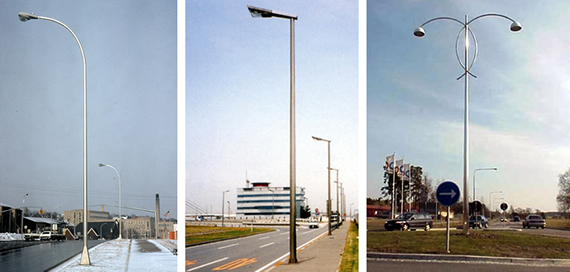Welcome to ‘Stainless Solutions’ from IMOA. Each month, we will cover a different stainless steel issue with tips on design and specification, and links to technical resources. This month’s issue provides information on light, flag and signage poles in stainless steel. |
| Stainless Steel Light, Flag & Signage Poles |
|
Stainless steel light, flag and signage poles are known to date back to at least 1944 in the US and they are a well-known older application in Japan and Europe as well. The oldest poles were made from the austenitic stainless steels 201, 304 or 316. The first use of duplex stainless steel poles may have been in the Canary Islands in 1991, when the alloy 2205 was used to provide a higher level of corrosion resistance than that of Type 316. Other duplex stainless steel alloys have subsequently been used for these applications.

These austenitic and duplex stainless steel light poles in the US (left), Japan (center) and Europe (right) were installed between 1964 and 2004. They are all still in use and have no maintenance requirements.
|
|
Design Considerations
The primary design requirements for these applications are adequate corrosion performance for the service environment, excellent fatigue strength, and, in some applications, impact toughness. While carbon steel, iron and aluminum are more commonly used for pole applications, stainless steel’s superior performance in all of these design categories makes it the most cost effective long-term choice. |
|
Corrosion Performance
Selection of a material should start with an assessment of the required level of corrosion resistance, particularly the presence of aggressive salts (coastal or deicing) or polluted environments. It is important to remember that constant pole movement due to wind loading can cause protective paint coatings to fail prematurely. They should therefore not be relied on unless regular maintenance repainting is acceptable. Metal coatings that are applied to improve the corrosion resistance of steel or aluminum can affect fatigue life and those implications must be considered. If an appropriate stainless steel alloy is specified, there is no need for a coating system.
Which stainless steel is most appropriate for a given application depends on whether the pole’s purpose is purely utilitarian or if there are aesthetic requirements. Type 316 stainless steel or the lean duplexes with similar corrosion resistance are often cost-effective long-term choices for poles, signage and fixtures in coastal areas and along busy roadways with deicing salt use. If the location is particularly corrosive, if coastal storm surge flooding might cause immersion, or if there are long-term aesthetic requirements, then a more corrosion-resistant stainless steel like 2205 duplex may be required. Please see the Selection section of IMOA’s website for alloy guidance and comparative metal corrosion data. |
 |
Type 316 stainless steel light fixtures in a coastal park in South Africa
Photo: Catherine Houska, Courtesy of the Nickel Institute |
|
Fatigue Performance
Corrosion and some aspects of design can play a significant role in fatigue performance and must be considered in a complete comparative analysis. The type of wind loading that can occur will also vary with the application. For example, the wind patterns caused by large vehicles must be considered for highway poles.
Aluminum highway poles are increasingly failing due to fatigue and stainless steel is a logical alternative. The exceptional fatigue performance of austenitic stainless steels (e.g. 201, 304, 316, etc.) is well known. Since poles will be cold worked (rolled, stretched, etc.), which increases their strength, it is interesting to note that duplex stainless steels have a higher fatigue limit than the austenitics at the same static strength. The fatigue limit increases with the static strength for both stainless steel alloy families.
The duplex and austenitic stainless steels are also much less notch sensitive than carbon steel. Furthermore, the effect of strength on notch sensitivity is significant for carbon steel but almost non-existent in these stainless steels.(1) Please see the Structural Design section of IMOA’s website for more information. |
|
Impact Toughness
Impact toughness can be important for some applications. The graph below provides general guidance on the relative impact toughness of different stainless steel families. Special processing, thickness, the level of cold work and welding are among the parameters that can affect the actual performance. The austenitics have the best performance of all pole options for low design temperatures.

|
|
(1) Rune Johansson and Hans Nordberg, “Fatigue Properties of Stainless Steel Strip”, AvestaPolarit R&D (now Outokumpu)
|
| Stainless Steel Library |
|
Download a free Stainless Steel Library (zip file, 559 MB) with over 360 pdfs covering building and construction applications, selection, specification, fabrication, sustainability and other common questions. |
| Stainless Solutions e-newsletter archive |
|
For previous issues or to subscibe to the e-newsletter, please visit the archive page. |
| Continuing Education – American Institute of Architects (AIA) |
|
IMOA is an AIA continuing education system approved provider with eight 1-hour programs that are registered for both live face-to-face and distance learning credit.
1. Stainless Steel Sustainable Design
2. Bioclimatic Design With Stainless Steel Weather Screens
3. Stainless Steel Structural Design
4. Stainless Steel Specification For Corrosive Applications
5. Deicing Salt: Stainless Steel Selection to Avoid Corrosion
6. Stainless Steel Finish Specification
7. Advanced Stainless Steel Specification and Problem Avoidance
8. Specification of Stainless Steel Finishes and Grades For Corrosive Applications
For more information or to schedule a workshop contact Catherine Houska, 412-369-0377 or email chouska@tmr-inc.com. |
| What is IMOA? |
|
IMOA (International Molybdenum Association) is a non-profit industry association, which provides technical information to assist with successful specification of molybdenum-containing materials. Molybdenum is an element. When it is added to stainless steel, molybdenum increases its resistance to corrosion caused by deicing salts, coastal atmosphere and pollution.
If you have a topic suggestion for a future issue of Stainless Solutions or need additional technical advice on stainless steel specification and selection, please get in touch here.
Forwarded by a colleague? To receive the next issue of Stainless Solutions automatically, please go to our archive and subscription page.
 
|
| Disclaimer |
|
In providing consultation or other assistance with respect to technical issues, any consultation, assistance or material is provided for the general information of the recipient and should not be used or relied upon for any specific application without first securing competent advice. IMOA and their respective employees, consultants and members (i) make no representation or warranty, express or implied, of any kind with regard to such consultation, assistance or material including no representation or warranty of suitability for any general or specific use; (ii) assume no liability or responsibility of any kind in connection therewith; and (iii) disclaim any and all liability for any claim that arises therefrom. |
|